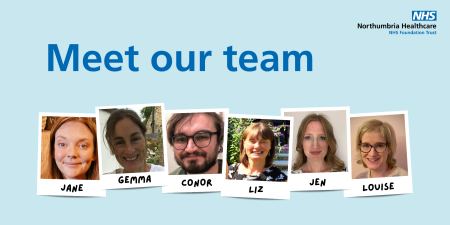
Why have I been referred to speech and language therapy?
This video was created by colleagues in Cambridge. It explains why some people are referred to respiratory (upper airway) speech and language therapy.
What do respiratory SLTs do?
Respiratory speech and language therapists (SLTs) specialise in the assessment and management of throat (laryngeal) symptoms that affect breathing and cough. These are often called upper airway disorders. The SLTs work as part of the respiratory multidisciplinary team in Northumbria Healthcare and have close links with the Ear, Nose and Throat (ENT) service at The Freeman Hospital. The respiratory SLTs in Northumbria also work closely with the trust's community SLTs.
The main upper airway symptoms that respiratory SLTs can help with are:
- Laryngeal hypersenstivity
This is where the nerve endings in the upper airway become very (‘hyper-‘) sensitive which can lead to excessive coughing and/or throat tightness, even when the airway is clear. Laryngeal hypersensitivity often happens after a cold, or virus, and can be made worse by the action of coughing itself, dryness in the upper airway, and/or if the airway is exposed to irritants e.g. smoke inhalation. Laryngeal hypersensitivity can lead to chronic cough and/or inducible laryngeal obstruction (ILO) – see below. - Chronic cough
This is a cough that lasts for 8 weeks or more that does not respond to medication. This cough is usually dry, and triggered by things like talking, laughing, strong smells, temperature change, and aerosol sprays. Some people bring up clear/ frothy mucus. - Inducible laryngeal obstruction (ILO)
This is a breathing difficulty that happens when throat muscles squeeze together tightly. It sometimes causes a choking sensation or noisy breathing (stridor). Symptoms typically come on suddenly in response to known triggers, are located in the throat, and are worse when breathing in.
Respiratory SLTs also specialise in voice changes, swallowing difficulties and throat irritation which often present alongside cough and ILO.
It is possible to have upper airway disorders on their own or to have both upper and lower airway disorders, eg, asthma.
For this reason, our respiratory SLTs also work in the:
Patient story
Patients are usually referred to this service from their respiratory doctor, nurse or physiotherapist. Before being referred to SLT, you should have had lung function tests.
SLTs use a range of assessments to better understand your symptoms, and to make a diagnosis and personalised treatment plan.
To make sure you get seen in the correct clinic, most patients receive a telephone triage first, which lasts about 15 minutes. This allows the SLT to get key information about your symptoms and plan your treatment. You may get some questionnaires to fill out with your appointment letter.
After the initial appointment, treatment options include:
- Self-management (using personalised recommendations) and ‘patient-initiated follow-up’: This is for people who opt for independent management of symptoms, who would like to initiate follow up themselves by calling or emailing the department at a later date if they think more SLT would be helpful.
- A telephone or video follow-up: This is for people who would like to try some self-management independently and receive a telephone or video call by the SLT to monitor their progress.
- A face to-face evaluation: This is for people who may have more complex symptoms, and need a more detailed assessment. It also allows the SLT to teach breathing exercises, which can be easier face to face.
- A nasendoscopy assessment: This is where the SLT has a more detailed look at your throat using a small camera which slides into your nose and gets a good view of your throat. This allows the SLT to look at how healthy the lining of your throat is, the size of your airway, and how the muscles are moving.
The SLT will explore factors that might be contributing to your symptoms. This helps them to understand why your symptoms started, and why they are still happening. They may wish to know about any:
- History of colds, viruses, or chest/throat infections
- History of smoking
- Daily water intake
- Exposure to dusty environments e.g. at work
- Whether you have reflux or sinus problems, and how these are managed
- Whether you use a spacer with your inhalers
- What usually triggers your symptoms
They will also want to know if, and how, your symptoms are affecting your daily life and wellbeing.
The key role of the SLT is to help diagnose upper airway disorders. This is done by working with other health professionals, reading reports from investigations, and by listening to your description of symptoms.
If you are diagnosed with laryngeal hypersensitivity, chronic cough and/or ILO, you will be offered to work with an SLT to:
- Understand how your voice box works.
- Understand breathing patterns & notice early warning signs of ILO symptoms.
- Identify ways to improve throat health.
- Learn exercises to release tension in the throat.
- Learn exercises to release tension in the jaw and tongue.
- Learn emergency breathing techniques to overcome symptoms.
- Explore ways to support your breathing in a range of environments/ situations
- Support your wellbeing, which can be affected by ILO.
SLT intervention usually takes 4 sessions. This includes a telephone assessment, a more detailed assessment (possibly including nasendoscopy), then a couple of follow-up sessions to monitor progress, and update exercises and advice if needed. Some people don’t need as many as 4, but some people need more.
The first goal of SLT is to determine whether your symptoms are related to upper airway disorders. If they are, SLTs then aim to:
- Reduce the severity of your symptoms
- Reduce how often you get symptoms
- Make you feel more confident controlling symptoms
- Reduce the impact that your symptoms are having upon your quality of life or wellbeing
- Know how to manage symptoms if they return in the future e.g. following a virus/cold.
It is not always possible to completely resolve symptoms. Outcomes will depend on different factors, such as how easy it is for people to:
- Make recommended lifestyle changes
- Practice the exercises regularly
- Manage ‘other’ factors that may be contributing to symptoms e.g acid reflux, sinus problems, medication use (e.g. ACE inhibitors)
RCSLT Giving Voice To People with Upper Airway Disorders: https://
Chronic Cough: https://
Inducible Laryngeal Obstruction: https://
Muscle Tension Dysphonia: http://www.britishvoiceassociation.org.uk/downloads/free-voice-care-literature/Muscle%20Tension%20Dysphonia.pdf
ILO/ VCD toolkit for professionals: ILOVCD Toolkit
